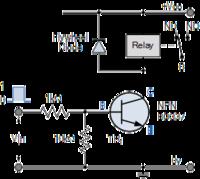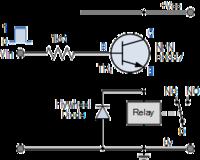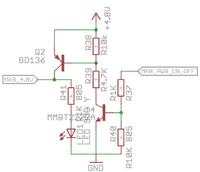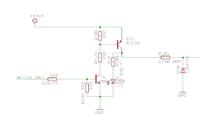Hi,
I design a PIC-controlled system and I want the transistor to be a kind of relay that turns the power on to equal electronic modules (e.g. VMusic3, Bluetooth, or DAB + MonkeyBoard radio) that are the periphery of the system (controlled by PIC).
In most cases, I encounter this kind of NPN transistor application:

However, in my case, it would be easier for me if I connected it like this:

Will the NPN transistor connection shown in the 2nd picture work and will I have something like an ON-OFF button controlled by the microcontroller output?
So far I have made a circuit consisting of an NPN and PNP transistor (as below), but I need a bit of this and I am starting to not fit in with the PCB space (and unfortunately I have little space and cannot change it).


I know that it can be done on one PNP transistor, but unfortunately due to the need to control the signals that enable the multiplexers, it will be easier for me with NPN.
I design a PIC-controlled system and I want the transistor to be a kind of relay that turns the power on to equal electronic modules (e.g. VMusic3, Bluetooth, or DAB + MonkeyBoard radio) that are the periphery of the system (controlled by PIC).
In most cases, I encounter this kind of NPN transistor application:

However, in my case, it would be easier for me if I connected it like this:

Will the NPN transistor connection shown in the 2nd picture work and will I have something like an ON-OFF button controlled by the microcontroller output?
So far I have made a circuit consisting of an NPN and PNP transistor (as below), but I need a bit of this and I am starting to not fit in with the PCB space (and unfortunately I have little space and cannot change it).


I know that it can be done on one PNP transistor, but unfortunately due to the need to control the signals that enable the multiplexers, it will be easier for me with NPN.


